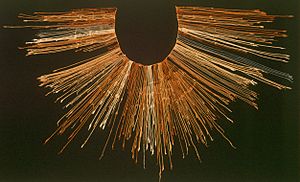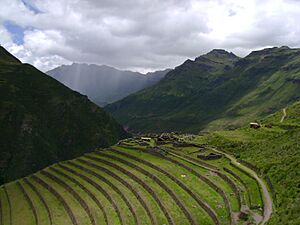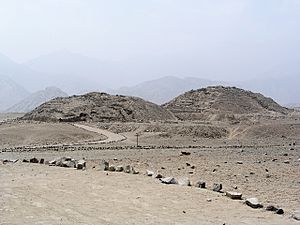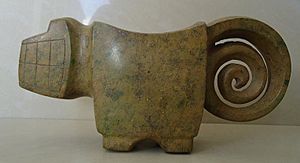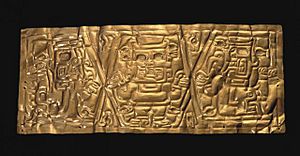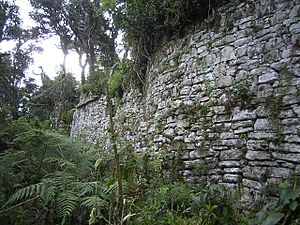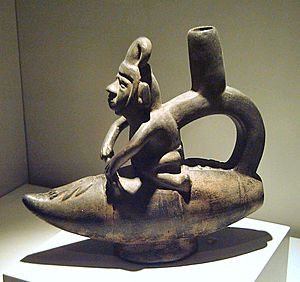Andean civilizations facts for kids
The Andean civilizations were amazing groups of people and cultures that lived mainly in the river valleys of the coastal deserts of Peru. These civilizations stretched from the Andes mountains in southern Colombia all the way down to Chile and northwest Argentina.
Experts believe that the first Andean civilizations started on the narrow coast next to the Pacific Ocean. The Caral or Norte Chico civilization in Peru is the oldest known civilization in the Americas. It began around 3200 BCE!
Even though they faced tough environmental challenges, these civilizations grew many different crops. Some of these crops became important all over the world. The Andean people were also famous for their huge buildings, beautiful woven textiles, and many other special ways of life.
Less than 100 years before the Spanish arrived, the Incas united most of the Andean cultures. Their empire, centered in the city of Cusco, covered almost all the areas we call Andean civilization today. Only the Timoto Cuica people in Venezuela stayed outside the Inca Empire. The Inca Empire was a mix of many languages, cultures, and peoples.
When the Spanish took over, they changed or ended many parts of the Andean civilizations. This especially affected their religion and buildings.
Contents
What Made Andean Civilizations Special?
The Andean civilization was one of only five in the world that scholars call "pristine." This means they grew on their own and didn't get ideas from other civilizations. Because they were cut off from other parts of the world, the people of the Andes had to find their own unique ways to solve problems.
Andean civilizations were different from other ancient civilizations in a few ways.
- First, they did not have a written language. Instead, they used the quipu. This was a system of knotted and colored strings to share information. Not many quipus still exist, and we haven't fully figured out what they all mean. Some scholars think quipus only recorded numbers. Others believe they could also tell stories, like a true writing system. People used quipus as far back as the Wari Empire (600–1000 CE). They might even have been used by the much older Caral/Norte Chico civilization around 3000 BCE.
- Second, Andean civilizations did not have wheeled vehicles or animals to pull things. People traveled only by walking. Goods were carried by humans or by llamas. Llamas are pack animals that could carry up to 45 kg (100 pounds). But llamas were not big or strong enough to pull plows or for adults to ride.
- Third, the Andean civilizations faced very tough environments. The earliest civilizations lived on the super-dry desert coast of Peru. Farming was only possible with irrigation in river valleys. These rivers came from the high Andes. There were also a few "fog oases" called lomas where plants could grow. In the Andes mountains, farming was hard because of thin soils, cold weather, little rain, and not much flat land. It could freeze any month of the year at heights over 3,000 meters (9,800 feet). Many highland Andean civilizations lived in these cold areas.
- Finally, the Andean civilizations did not use money. Copper "axe-monies" and Spondylus shells were used for trade in some areas, especially coastal Ecuador. But most of the Andes region had economies based on sharing and trading goods, not on money and markets. These ways of doing things were very clear during the Inca Empire. But they actually started much earlier.
How They Farmed and Grew Food
Farming in South America might have started in coastal Ecuador around 8000 BCE. The Las Vegas culture domesticated squash there.
Some experts think the first civilizations on the Peruvian coast relied more on food from the sea than on farming at first. However, like in all civilizations until the late 1800s, farming was the main job for most people. The biggest gift Andean civilization gave to the modern world is the plants they domesticated.
Many crops grown by the Andean people were unique to their region. Maize (corn), which came to the Andes from Mexico, was often the most important crop in lower and middle elevations. The Andean people grew an estimated 70 different plants! This is almost as many as were grown in all of Europe and Asia combined. Many of these plants are not grown much today. But important plants that started in or near the Andes include potatoes, quinoa, tomatoes, chile peppers, cotton, coca, tobacco, pineapples, peanuts, and several types of beans. The only animals they domesticated were llamas and guinea pigs.
The tough environment meant they needed smart farming methods. Unlike the Middle East, the Andes didn't have easy-to-grow plants like wheat and barley. They also didn't have large, easily tamed animals like horses and cattle. Farming on the desert coast needed irrigation systems. In the mountains, the high elevation, cold weather, and steep land required many solutions. These included terraces (andén), using small areas with different climates, and selective breeding of plants. Because the weather was unpredictable, farmers usually grew several crops at different heights and locations. This increased their chances of a good harvest. On a larger scale, societies and states did the same. They set up colonies at different elevations to improve farming success.
Ancient Andean Cultures
Caral Civilization
The Norte Chico civilization, also called Caral, was a complex society that existed before Christopher Columbus. It had as many as 30 large population centers in what is now north-central coastal Peru. It is the oldest known civilization in the Americas. It is also one of the places where civilization started on its own in the ancient world. This civilization thrived between 3000 BCE and 1800 BCE. The name Caral-Supe comes from the Sacred City of Caral in the Supe Valley. This is a large and well-studied Norte Chico site. The complex society in Norte Chico began about 1,000 years after Sumer in Mesopotamia. It existed at the same time as the Egyptian pyramids. And it was nearly 2,000 years before the Mesoamerican Olmec civilization.
Valdivia Culture
The Valdivia Culture is one of the oldest settled cultures found in the Americas. It grew out of the earlier Las Vegas culture. It flourished on the Santa Elena peninsula near the modern town of Valdivia, Ecuador. This was between 3500 BCE and 1800 BCE.
Chavín Culture
The Chavín culture is believed to have been mostly a religious movement. This culture seems to have started in the Peruvian highlands. Then it spread throughout the country. The Chavín culture has very unique art styles. This is especially true for their effigy pots, many of which were shaped like cats. Chavin de Huantar was an important religious center for the Chavin Culture. It dates back to around 1500 BCE.
Nazca Culture
The Nazca culture thrived from 100 to 800 CE. They lived along the dry southern coast of Peru in the river valleys of the Rio Grande de Nazca and the Ica Valley. The Nazca were greatly influenced by the earlier Paracas culture, which was known for its amazing textiles. The Nazca created many beautiful crafts and technologies. These included ceramics, textiles, and geoglyphs (most famously the Nazca lines). They also built an impressive system of underground aqueducts, called puquios, which still work today. The Nazca Province in the Ica Region was named after these people.
Moche Culture
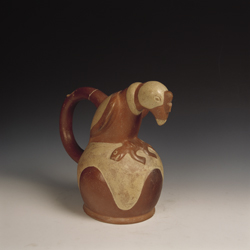
The Moche civilization flourished in northern Peru from about 100 CE to 800 CE. Many scholars believe the Moche were not one big empire. Instead, they were likely a group of independent groups that shared a common culture. This can be seen in their rich art and huge buildings that still exist today. They are especially known for their beautifully painted ceramics, gold work, large constructions (huacas), and irrigation systems. Moche history can be divided into three main periods: the start of the Moche culture (100–300 CE), its growth and peak (300–600 CE), and its decline (500–750 CE).
Chachapoyas Culture
The Chachapoyas, also known as the 'Cloud People', were an Andean civilization. They lived in the cloud forests of the Amazonas region in what is now northern Peru. The Incas conquered the Chachapoyas just before the Spanish arrived in Peru. The first clear proof of their existence dates back to around 700 CE. However, it's possible they built a settlement called Gran Pajáten where some pottery has been dated to 200 BCE. The largest Chachapoyan site found so far is Kuelap. Many mummified burial sites have also been discovered.
Wari Culture
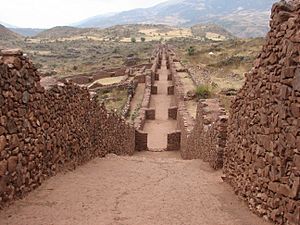
The Wari were a civilization that thrived in the south-central Andes and coastal area of Peru. This was from about 500 CE to 1000 CE. The city of Wari was their former capital. It is located about 11 km (7 miles) northeast of the city of Ayacucho. This city was the center of a civilization that covered much of the highlands and coast of Peru. The best-preserved remains, besides the Wari Ruins, are the recently found Northern Wari ruins near the city of Chiclayo. Also well-known are the Wari ruins of Pikillaqta ("Flea Town"), a short distance southeast of Cuzco on the way to Lake Titicaca.
Tiwanaku Culture
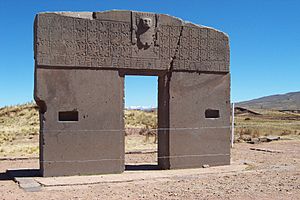
Tiwanaku is an important ancient archaeological site in western Bolivia, South America. Experts see Tiwanaku as one of the most important cultures before the Inca Empire. It was a major state's religious and administrative capital for about 500 years. The ruins of this ancient city are near the southeastern shore of Lake Titicaca. This is in the La Paz Department, about 72 km (45 miles) west of La Paz.
The site was first written about by the Spanish conqueror Pedro Cieza de León. He found the remains of Tiwanaku in 1549 while looking for the Inca capital. Some people think Tiwanaku's modern name comes from the Aymara term taypiqala. This means "stone in the center," suggesting it was believed to be the center of the world. However, the original name the people of Tiwanaku used might be lost. This is because they had no written language.
Later Andean Cultures
Chimú Culture
The Chimú people lived in the kingdom of Chimor. Their capital city was Chan Chan, a large city made of adobe bricks in the Moche Valley of present-day Trujillo, Peru. This culture began around 900 CE. The Inca ruler Topa Inca Yupanqui conquered the Chimú around 1470 CE.
This happened only 50 years before the Spanish arrived in the region. Because of this, Spanish writers were able to record stories about Chimú culture from people who had lived before the Inca conquest. Also, archaeological evidence suggests that Chimor grew from what was left of the Moche culture. Early Chimú pottery looked somewhat like Moche pottery. Their ceramics are all black, and their work with precious metals is very detailed and complex.
Inca Empire
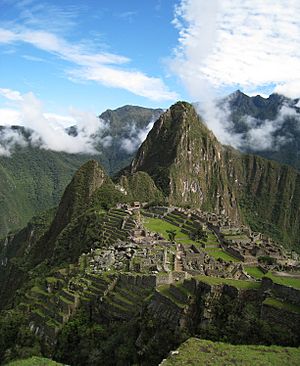
The Inca Empire, also called Tawantinsuyu in Quechua, was the largest empire in the Americas before the arrival of Europeans. The main center of the empire was in Cusco. The Inca civilization started in the Peruvian highlands around the early 1200s. The last Inca stronghold was conquered by the Spanish in 1572.
From 1438 to 1533 CE, the Incas used different ways to expand their empire. They conquered some areas and peacefully joined with others. They brought together a large part of western South America. This area was centered on the Andes mountains. It included Peru, southwest Ecuador, western and south-central Bolivia, northwest Argentina, northern Chile, and a small part of southwest Colombia. Their empire was similar to the large empires of the Old World.
Muisca People
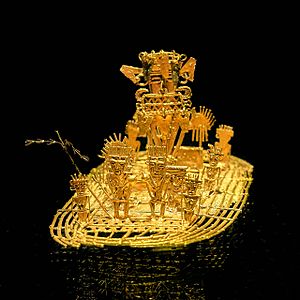
The Muisca were a group of people who spoke the Chibcha language. They formed the Muisca Confederation in the central highlands of present-day Colombia. Spanish troops led by Gonzalo Jiménez de Quesada met them in the spring of 1537 during the conquest.
The Muisca had two main groups. One was Hunza (modern-day Tunja) in the north, led by the zaque. The other was Bacatá in the south, led by the zipa. Both groups lived in the highlands of modern-day Cundinamarca and Boyacá in the central part of Colombia's Eastern Ranges.
Timoto-Cuica People
The Timoto–Cuica people were mainly made up of two tribes: the Timotes and the Cuicas. They lived in the Andean region of western Venezuela. They were closely related to the Muisca people of the Andes, who spoke a Chibcha language. The Timoto-Cuicas also included other groups like the Mucuchíes, Migures, Tabares, and Mucuñuques.
Timoto-Cuica society was well-organized. They had permanent villages that were planned out. These villages were surrounded by terraced fields that used irrigation. They also stored water in tanks. Their houses were mostly made of stone and wood with thatched roofs. They were mostly peaceful and relied on growing crops. Local crops included potatoes and ullucos. They left behind works of art, especially human-shaped ceramics, but no large monuments. They spun plant fibers to weave into textiles and mats for their homes. They are believed to have invented the arepa, a common food in Venezuelan and Colombian cuisine.
See also
 In Spanish: Civilizaciones andinas para niños
In Spanish: Civilizaciones andinas para niños



